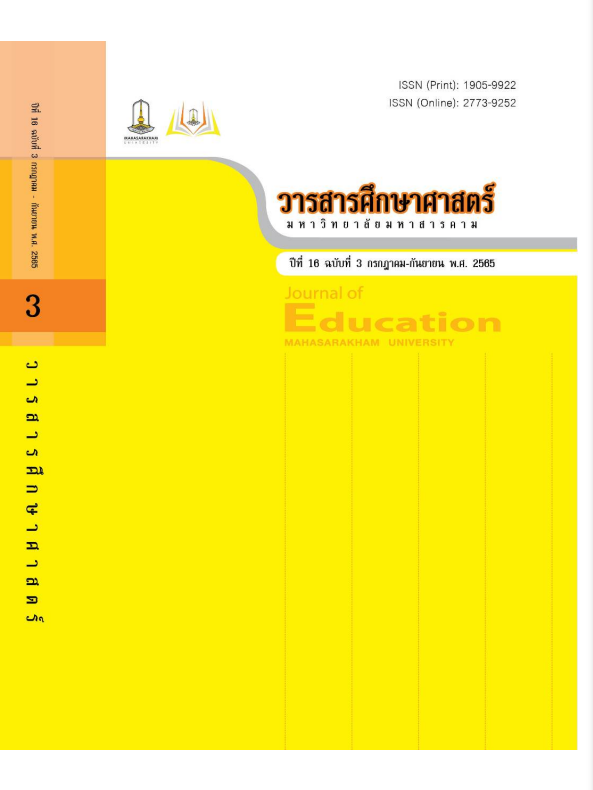The Development of Learning Management Model of Chemistry Subject to Enhance Academic Achievement and Critical Thinking of Mathayomsuksa 4 Students
Main Article Content
Abstract
The objectives of research study were 1) elements of critical thinking, 2) study current state and problematic conditions in management of chemistry learning to enhance academic achievement and critical thinking for mathayomsuksa 4 students, 3) develop academic achievement and critical thinking for mathayomsuksa 4 students, 4) study the results model. The group informants consisted of 7 experts who were selected by specific means. The sample group included secondary school year 4 students at Anukoolnaree school, under the secondary educational service area office 24 semester 1, academic year 2020, 30 people were obtained by using a specific sample group. Research tools are: assessment form examines the suitability of components critical thinking, interview form, focus group conversation recording, assessment form for suitability model, achievement test, critical thinking test, satisfaction assessment form. This research was conducted in accordance with the nature of research and development processes (Research and Development), to analyze the average, percentage, standard deviation, t-test, content analysis.
The research results found that:
1) Learning factor and indicators of critical thinking were 6 main learning factor and 38 indicators, which composes of; 1) inductive thinking, 2) deduction thinking, 3) question, 4) interpretation, 5) recognition of assumptions, 6) evaluation of arguments. The results of suitability assessment were at the highest level.
2) General conditions and problems in chemistry learning management to enhance academic achievement and critical thinking for mathayomsuksa 4 students, chemistry teachers tried to manage learning chemistry. But students still have not encourage critical thinking.
3) Learning management model of chemistry subject to enhance academic achievement and critical thinking for mathayomsuksa 4 components as follows: 1) probing problems 2) data collection 3) cultivation 4) practice 5) conclusion and 6) measurement and evaluation. This called PDCPCM model, have efficiency 75.25/73.46.
4) The results of learning management model were found that 1) students had higher learning achievement after school than before, 2) students had the ability to think critically. after the study was higher than the group that received normal learning management, 3) students had a high level of satisfaction.
Downloads
Article Details

This work is licensed under a Creative Commons Attribution-NonCommercial-NoDerivatives 4.0 International License.
References
กฤษณา โลหการก และคณะ. (2559). การพัฒนารูปแบบการจัดการเรียนรู้วิทยาศาสตร์ที่ส่งเสริมการคิดอย่างมีวิจารณญาณสำาหรับนักเรียนชั้นมัธยมศึกษาปีที่ 1 ในโรงเรียนขยายโอกาสทางการศึกษา. วารสารการศึกษาและการพัฒนาสังคม, 12(1), 35-47.
กุณฑรี เพ็ชรทวีพรเดช และคณะ. (2558). การพัฒนารูปแบบการจัดการเรียนรู้วิทยาศาสตร์เพื่อส่งเสริมการคิดอย่างมีวิจารณญาณของนักเรียนชั้นมัธยมศึกษาตอนปลาย. วารสารมหาวิทยาลัยนครพนม, 5(2), 24-32.
กระทรวงศึกษาธิการ. (2560). ตัวชี้วัดและสาระการเรียนรู้แกนกลาง กลุ่มสาระการเรียนรู้วิทยาศาสตร์ (ฉบับปรับปรุง พ.ศ.2560) ตามหลักสูตรแกนกลางการศึกษาขั้นพื้นฐาน พุทธศักราช 2551. กรุงเทพฯ: โรงพิมพ์ชุมนุมสหกรณ์การเกษตรแห่งประเทศไทย จำากัด.
ฉันชัย จันทะเสน. (2558). การพัฒนารูปแบบการจัดการเรียนรู้วิทยาศาสตร์เพื่อส่งเสริมการคิดอย่างมีวิจารณญาณของนักเรียนชั้นมัธยมศึกษาตอนปลาย. วิทยานิพนธ์ ปริญญาปรัชญาดุษฎีบัณฑิต มหาวิทยาลัยมหาสารคาม.
ชนาธิป พรกุล. (2554). การสอนกระบวนการคิดทฤษฎีและการนำาไปใช้. พิมพ์ครั้งที่ 2. กรุงเทพฯ: วีพริ้นท์ (1991) จำากัด.
ชัยวัฒน์ สุทธิรัตน์. (2553). การจัดการเรียนรู้แนวใหม่. นนทบุรี: สหมิตรพริ้นติ้ง แอนด์พับลิสซิ่ง.
ทิศนา แขมมณี. (2554). วิทยาการด้านการคิด. กรุงเทพฯ เดอมาสเตอร์กรุ๊ป แมเนจเม้นท์.
ทิศนา แขมมณี. (2557). ศาสตร์การสอน: องค์ความรู้เพื่อการจัดกระบวนการเรียนรู้ที่มีประสิทธิภาพ. พิมพ์ครั้งที่ 18. กรุงเทพฯ: จุฬาลงกรณ์มหาวิทยาลัย.
ธนัชชา นวนกระโทก และคณะ. (2564). ผลการจัดการเรียนรู้โดยใช้วัฏจักรการสืบเสาะหาความรู้ 5 ขั้น ร่วมกับเทคนิคจิ๊กซอว์ II ที่มีต่อผลสัมฤทธิ์ทางการเรียน พฤติกรรมการทำงานกลุ่ม และจิตวิทยาศาสตร์. วารสารศึกษาศาสตร์ มหาวิทยาลัยมหาสารคาม, 15(2), 94-108.
บุญชม ศรีสะอาด. (2554). การวิจัยเบื้องต้น. พิมพ์ครั้งที่ 9. กรุงเทพฯ: บริษัท สุวีริยาสาส์น จำกัด.
พิมพันธ์ เดชะคุปต์ และคณะ. (2551). ทักษะ 5C เพื่อการพัฒนาหน่วยการเรียนรู้และการจัดการเรียนการสอนอิงมาตรฐาน. กรุงเทพฯ: จุฬาลงกรณ์มหาวิทยาลัย.
ลักขณา สริวัฒน์. (2549). การคิด. กรุงเทพฯ: โอเดียนสโตร์.
วุฒิ ถนอมวิริยะกุล. (2562). การพัฒนารูปแบบการจัดการเรียนรู้วิทยาศาสตร์เพื่อส่งเสริมการคิดอย่างมีวิจารณญาณ สำหรับนักเรียนชั้นประถมศึกษาปีที่ 6. วิทยานิพนธ์ กศ.ด. มหาวิทยาลัยบูรพา.
สถาบันส่งเสริมการสอนวิทยาศาสตร์และเทคโนโลยี. (2558). การสอนแบบสืบเสาะหาความรู้. กรุงเทพฯ: สถาบันส่งเสริมการสอนวิทยาศาสตร์และเทคโนโลยี.
สำานักงานรับรองมาตรฐานและการประเมินคุณภาพการศึกษา (องค์การมหาชน). (2557). ผลประเมิน
สถานศึกษาระดับขั้นพื้นฐาน รอบสาม (พ.ศ. 2554-2558).
สำานักงานเลขาธิการสภาการศึกษา. (2550). รูปแบบการจัดการเรียนรู้เพื่อพัฒนาความสามารถของเด็ก
ในการอ่าน คิด วิเคราะห์ เขียน และสร้างองค์ความรู้ด้วยตนเอง โดยเน้นผู้เรียนเป็นสำคัญ. กรุงเทพฯ: สำนักงานฯ.
สำนักงานเลขาธิการสภาการศึกษา. (2552). ข้อเสนอการปฏิรูปการศึกษาในศตวรรษที่สอง (พ.ศ.2552-2561). กรุงเทพมหานคร: บริษัท พริกหวานกราฟฟิค จำกัด.
สุวิทย์ มูลคำ และอรทัย มูลคำา. (2547). 9 วิธีการจัดการเรียนรู้: เพื่อพัฒนาความรู้และทักษะ. พิมพ์ครั้งที่ 4. กรุงเทพฯ: ภาพพิมพ์.
Anderson, T.P. & RomisZowski, A.J. (1997). Instructional development paradigms. Englewood Cliffs, NJ: Education Technology Publications.
Arends, R.I. (1997). Classroom instruction and management. New York: McGraw Hill.
Brown, James W., Lewis, Richard B., Harcleroad, Fred F. (1983). AV. Instruction technology, media and method. New York: McGraw-Hill.
Bruning, R.H., Schraw, G.J., Norby, M.M. (2011). Cognitive psychology and instruction (5th ed.). Boston, MA: Pearson.
De Bono, Edward. (1985). Six thinking Hats. London: Penguin Book.
De Bono, Edward. (1976). Teaching thinking. London: Temple Smith.
Dick, W. & Carey, L. (1996). The Systematic design of instruction. 4th ed. New York HarperCollins College Publishers.
Eisenkraft, A. (2003). Expanding the 5E model. The Science Teacher, 70(6), 56-59.
Elliott, Brett M. (1999). The Influence of an Interdisciplinary Course on Critical Thinking Skills. Dissertation for the Degree of Doctor of Philosophy, University of North Texas, Denton, Texas.
Gagne, R.M. & Briggs, A.M. (1979). Principles of instructional design. New York: Holt, Rinehart and Winston.
Gerlach, V.S. & Ely, D.P. (1971). Teaching and media: A systematic approach. Englewood Cliffs, NJ: Prentice-Hall.
Glaser, Robert. (1965). Toward a behavioral science base for instructional design. In: R. Glaser (Ed.). Teaching machines and programmed instruction, II: data and directions. Washington: Department of Audiovisual Instruction, National Education Association.
Joyce, B., Weil, M. & Calhoun, E. (2011). Models of teaching. 9th ed. Boston, MA: Pearson Education Inc.
Kemp, J.E. (1977). Instructional design: A plan for enit and course development. Califormia: Fearon-Pitman Pullishers, Inc.
Klausmeier, H.J. & Ripple, R.E. (1971). Learning and human abilities: Educational psychology. 3rd ed. New York: Harper and Row.
Remley, T.D. (2002). Foreword-special issue: Legal and ethical issues in school counseling. Professional School Counseling. Retrieved from http://find articles.com/p/articles/mi_m0KOC/is_1_6/ai_93700933/?tag=rbxcra.2.a.22.
Tyler, R.W. (1950). Basic principles of curriculum and instruction. Chicago: University of Chicago Press.
Vishwanath, H.N. (2006). Model of teaching in environmental education. Discovery Publishing House: New Delhi.

